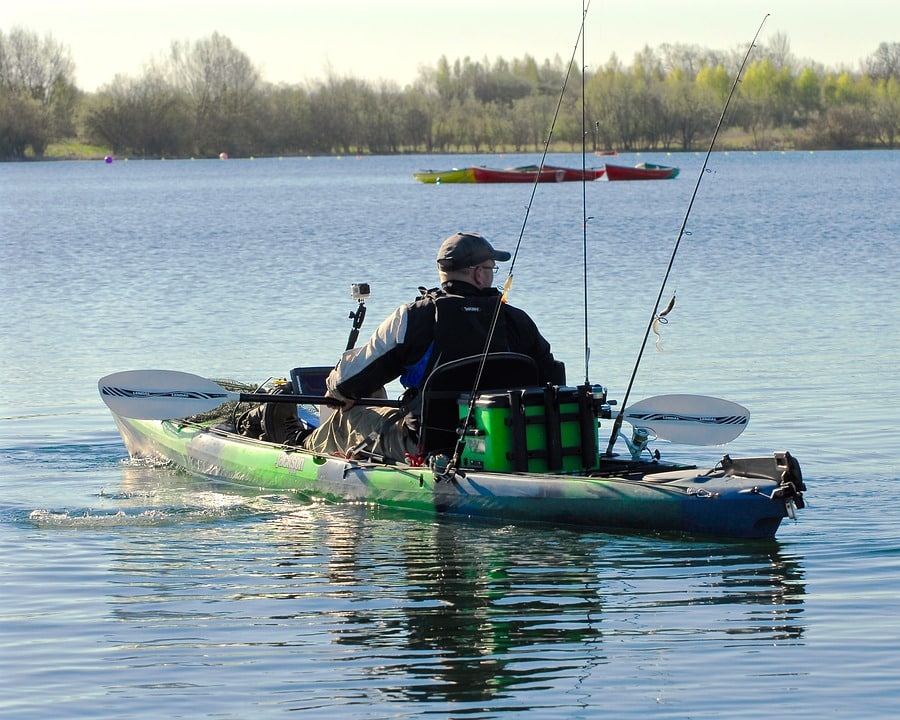Whether you’re an avid kayaker or just getting your feet wet in this adventurous sport, knowing the weight of a kayak is crucial. Why, you might ask? Well, it’s not just about handling and balance when you’re out on the water. The weight of your kayak affects how easily you can transport it, whether you can manage it solo, and if it’s even compatible with your car’s roof rack.
So, how much do kayaks weigh? The average kayak weight varies considerably depending on the type of kayak. A recreational kayak, for instance, might weigh around 35-50 pounds (16-23 kg), while a tandem kayak could weigh up to 75 pounds (34 kg). Then you have fishing kayaks, touring kayaks, and inflatable types—each with their weight ranges.
In this comprehensive guide, we’ll dive deeper into the factors that contribute to a kayak’s weight, such as materials, dimensions, and additional accessories. If you’re in the market for a new kayak or just curious, stick around. We’ve got a lot to cover.

Key Takeaways
☑️ How does kayak weight affect handling and transport? Lighter kayaks are nimbler and easier to carry, ideal for calm waters and solo kayakers. Heavier kayaks ensure stability and durability, suited for rough waters and carrying more gear.
☑️ What determines a kayak’s weight? Material choice—like polyethylene for durability and composites for lightness—and size directly influence weight. Heavier materials increase stability but complicate transportation.
☑️ Why consider weight when choosing a kayak? It dictates ease of transport, performance on the water, and safety. The right balance between weight and functionality is crucial, especially for longer trips or challenging conditions.
Why Does Kayak Weight Matter?
Performance on Water
The weight of a kayak is a key determinant of how it performs on water. Heavier kayaks, for instance, may be slower but offer greater stability, making them ideal for rough waters.
Lighter kayaks, on the other hand, are often easier to maneuver and faster, which might make them better suited for calm waters. If you’re a beginner, understanding the kayak’s weight in relation to its performance can help you make a more informed decision for your water expeditions.
Safety Concerns
Safety is paramount when it comes to any water sport, and kayaking is no exception. Knowing the weight limit and maximum weight capacity of your kayak is crucial for a safe and enjoyable outing. Exceeding these limits can lead to your kayak becoming unstable, increasing the risk of tipping over.
Plus, being aware of the kayak weight limit helps you know just how much additional gear you can safely bring along. This becomes especially important if you’re planning a multi-day tour or carrying extra equipment for activities like fishing.
In summary, knowing your kayak’s weight is not just about the convenience of transporting it. It significantly impacts its performance and safety, especially when navigating different types of water conditions.

How Materials and Dimensions Affect the Weight of a Kayak
Common Materials
When it comes to kayak construction, materials play a significant role in determining the overall weight. Composite materials like fiberglass and carbon fiber are known for their lightweight characteristics, making them popular choices for performance-focused kayaks. However, these materials can be on the pricier side.
On the other hand, polyethylene plastic is commonly used for recreational kayaks. This material is heavier than composites but offers durability and is generally more cost-effective. The type of material you choose will not only affect the kayak’s weight but also its performance and durability.
Kayak Dimensions
Another factor that contributes to a kayak’s weight is its dimensions, primarily its length and width. Longer kayaks naturally weigh more due to the added materials, but they offer better tracking and stability in rough waters.
On the flip side, shorter kayaks might weigh less, but may not offer the same level of stability or tracking. Wider kayaks also contribute extra weight but provide more stability, particularly useful for beginners or those interested in fishing or photography from their kayak.
Understanding the correlation between materials and dimensions can guide you in making an informed decision when choosing a kayak. Whether you prioritize a lightweight kayak material like carbon fiber or opt for a longer, more stable kayak, each choice will directly impact the weight and, consequently, how you interact with the water.
How much do different kayak types weigh?
Recreational Kayaks
How much does a recreational kayak weigh? On average, recreational kayaks weigh between 35 to 50 pounds (16 to 23 kg).
Recreational kayaks are generally lighter and designed for casual paddling in calm waters. They are often made from polyethylene plastic, which is durable but not the lightest option. These kayaks are popular for their ease of use and stability.
Here are some examples of recreational kayaks:
- Sun Dolphin Aruba 10: 40 pounds (18 kg)
- Pelican Maxim 100X: 36 pounds (16 kg)
- SUN DOLPHIN ARUBA 12 SS: 47 pounds (21 kg)

Tandem Kayaks
How much does a tandem kayak weigh? Generally, tandem kayaks weigh between 60 to 85 pounds (27 to 39 kg).
Tandem kayaks are designed for two paddlers and naturally weigh more due to the extra seating and storage space. They often use heavier materials for durability and can be more challenging to maneuver due to the added weight.
Here are some examples of tandem kayaks:
- Ocean Kayak Malibu Two: 57 pounds (26 kg)
- Seaward G3 Passat: 90 pounds (41 kg)
- Intex Explorer K2: 31 pounds (14 kg), an inflatable tandem kayak option
Inflatable Kayaks
How much does an inflatable kayak weigh? Inflatable kayaks are usually the lightest, weighing between 20 to 40 pounds (9 to 18 kg).
Inflatable boats are ideal for those who prioritize portability. Much lighter than hardshell kayaks, they are usually made from a lightweight material like PVC and can easily be deflated for transport.
Here are some examples of inflatable kayaks:
- Intex Challenger K1: 27 pounds (12 kg)
- Sea Eagle SE370: 32 pounds (15 kg)
- INTEX Excursion Pro (tandem): 44 pounds (20 kg)

Whitewater Kayaks
How much does a whitewater kayak weigh? Whitewater kayaks are typically lighter, averaging between 30 to 50 pounds (14 to 23 kg).
Designed for agility and quick maneuvering through rapid waters, these kayaks are generally shorter and made of lighter materials like polyethylene.
Here are some examples of whitewater kayaks:
- Dagger Mamba: 44 pounds (20 kg)
- Pyranha Burn III: 47 pounds (21 kg)
- Jackson Zen: 40 pounds (18 kg)
Fishing Kayaks
How much does a fishing kayak weigh? Fishing kayaks can be heavier and their weight can vary a lot, but generally their ranging from 70 to 130 pounds (32 to 59 kg).
These kayaks are generally more substantial to accommodate fishing accessories and additional gear. Many are built with extra storage and stability features, adding to the weight.
Here are some examples of fishing kayaks:
- Hobie Mirage Pro Angler 14: 120 pounds (54 kg)
- Pelican Sentinel 100X Angler: 45 pounds (20 kg)
- Old Town Topwater 120 PDL: 100 pounds (45 kg)

Touring and Sea Kayaks
How much does a touring and sea kayak weigh? These kayaks are usually on the heavier side, weighing between 50 to 70 pounds (23 to 32 kg).
Touring and sea kayaks are designed for long-distance paddling and often come with additional storage space. They are typically longer and use heavier, more durable materials. Here’s an in-depth comparison with river kayaks.
Here are some examples of touring and sea kayaks:
- Delta Kayaks 17: 50 pounds (23 kg)
- Wilderness Systems Tempest 170: 57 pounds (26 kg)
- Necky Chatham 18: 53 pounds (24 kg)
By understanding the typical weights of different kayak types, you can make a more informed choice depending on your needs, whether you prioritize a lighter boat or one built for specific activities.
Overview Table: Kayak Types and Their Weight
Here’s a quick reference table that provides a snapshot of various kayak types and their weight. This should give you a handy overview.
| Type of Kayak | Average Weight (lbs) [kg] | Average Weight Capacity (lbs) [kg] | Use Case |
|---|---|---|---|
| Recreational Kayaks | 35 – 50 [16 – 23] | 250 – 300 [113 – 136] | Casual paddling |
| Tandem Kayaks | 60 – 85 [27 – 39] | 400 – 600 [181 – 272] | Two-person paddling |
| Inflatable Kayaks | 20 – 40 [9 – 18] | 200 – 400 [91 – 181] | Casual paddling, Easy transport and storage |
| Fishing Kayaks | 70 – 130 [32 – 59] | 400 – 750 [181 – 340] | Fishing |
| Whitewater Kayaks | 30 – 50 [14 – 23] | 150 – 250 [68 – 113] | Rapids and fast waters |
| Touring and Sea Kayaks | 50 – 70 [23 – 32] | 300 – 450 [136 – 204] | Long-distance paddling |
From the lightest kayaks like inflatable kayaks to the heaviest kayak options often found in the fishing category, this table encapsulates the typical kayak weight ranges you might encounter.
The Pros and Cons of Light vs. Heavy Kayaks
Advantages of Light Kayaks
- Easy to Transport: One of the biggest perks of a lighter kayak is the ease of transportation. You can easily lift it onto a car roof or kayak cart.
- Quick Maneuvering: Light kayaks respond more promptly to paddle strokes, making them easier to steer and maneuver.
- Less Fatigue: Paddling a lighter boat can reduce muscle fatigue, especially on longer trips.
Disadvantages of Light Kayaks
- Instability in Rougher Waters: A lighter kayak may not hold up well in rougher waters, where extra weight can provide added stability.
- Limited Gear Capacity: The downside of a lighter design usually includes less room for additional gear or any extra weight you might want to carry.
Advantages of Heavy Kayaks
- Stability: The heavy boat design generally offers better stability, especially in rougher waters.
- More Room for Gear: Heavier kayaks often have a larger carrying capacity, allowing for additional gear and even extra weight like fishing equipment.
Disadvantages of Heavy Kayaks
- Transport Challenges: The extra pounds make the kayak difficult to move around, requiring more effort or even a special kayak trailer.
- Increased Fatigue: Over longer distances, a heavier kayak can lead to greater physical fatigue as you need to exert more energy to keep it moving.
Each type has its pros and cons, so consider what you’re looking for in a kayak—the ease of a light kayak or the stability and gear capacity of a heavier one.

How to Transport Kayaks
Kayak Trailers
For those who own heavier kayaks or multiple kayaks, a kayak trailer might be the best option. Trailers can haul more weight and often come with additional spaces for storing gear or even other watercraft. They attach to the back of your vehicle, and since they’re designed for this specific purpose, they make transporting heavier kayaks much simpler.
Kayak Carts
Another option for moving your kayak from point A to B is a kayak cart. These are particularly useful if you don’t have to cover a long distance. Kayak carts are wheeled frames that you can load your kayak onto, making it easier to transport it over short distances. These carts are extremely handy when you’re alone or when your kayak has additional accessories making it heavier than usual.
Kayak Roof Rack
Lastly, roof racks are a classic and popular method for transporting kayaks. This is a versatile option that fits most vehicles. While it’s generally easier to load lighter kayaks onto a roof rack, with the right technique and perhaps an extra pair of hands, even a heavier kayak can be safely and securely transported this way.
Whether you choose a trailer, cart, or roof rack will depend on several factors including the type of vehicle you own and the weight of your kayak. Each option has its own set of pros and cons but will ultimately get the job done. Choose wisely based on your individual needs.

Kayaks vs. Canoes: Which Watercraft Weighs More?
Kayak Weight
When we talk about the weight of kayaks, it varies significantly depending on the type and materials used. However, on average, kayaks weigh between 35 to 50 pounds (16 to 23 kg). It’s essential to know not just the kayak weight but also the weight limit or capacity, especially if you plan to carry additional gear.
Canoe Weight
Canoes, in general, are larger vessels and thus typically weigh more. The average weight for a canoe is approximately 55 to 70 pounds (25 to 32 kg). Unlike kayaks, canoes are often designed to carry more gear or even an extra person, which is why the weight capacity is generally higher.
So, which watercraft weighs more? Generally speaking, canoes tip the scale higher than kayaks. They’re designed for different purposes, and this difference in weight reflects those purposes. Canoes are bulkier and better suited for longer trips with more gear or people, whereas kayaks are lighter and more agile, designed for speed and maneuverability. It’s all about what you need on the water.

Frequently Asked Questions
How much does a kayak weigh in kg?
Most kayaks weigh between 20 to 35 kg, but this can vary depending on the type and material of the kayak. This is just the actual weight of the kayak and doesn’t include any additional accessories or fishing gear that you might add.
How heavy is the average single-person kayak?
Single kayaks are generally lighter compared to other types, often weighing around 45-50 pounds (20-23 kg). The weight can fluctuate based on material and any extra features the kayak might have.
What is the weight of a 10 ft kayak?
A 10 ft kayak typically weighs between 40 to 50 pounds (18-23 kg). The weight varies depending on the material used and whether it is equipped with additional features like rod holders or storage compartments.
Why do fishing kayaks weigh more than normal kayaks?
Fishing kayaks are generally heavier because they’re built to hold more weight capacity including fishing gear, tackle boxes, and sometimes even a cooler. The additional compartments and features contribute to the weight. They often weigh between 70-100 pounds (32-45 kg).
Are kayaks heavier than canoes?
Your average kayak is lighter than your average canoe. Canoes are built for more versatile use including carrying more passengers and gear, which generally makes them heavier. A typical canoe can weigh around 65-85 pounds (29-39 kg), whereas kayaks are generally in the 35-70 pound (16-32 kg) range.
How much weight can an average tandem kayak hold?
Tandem kayaks are designed to hold more weight given that they are made for two people. They usually have a weight capacity ranging from 400 to 600 pounds (181-272 kg). The weight capacity includes both passengers and any additional gear you may be bringing along.

Conclusion – How Much Do Kayaks Weigh?
Knowing the weight of your kayak is crucial for safety, performance, and convenience. Whether you’re a beginner or a seasoned kayaker, understanding the weight limits and how different materials and dimensions affect your kayak can guide you toward a more enjoyable experience on the water. Always consult your kayak manufacturer for the most accurate weight information, as these factors can vary.
From considerations like safety in rough or calm waters to the intricacies of transporting heavier kayaks, this guide has aimed to provide a comprehensive look at what you should know about kayak weight. Now that you’re armed with this knowledge, you’re better prepared for your next kayaking adventure.
For more in-depth information and tips on kayaking and other outdoor sports, feel free to check out other content on The Sporting Edge. We’ve got a wealth of resources to help you make the most of your outdoor activities. Happy kayaking!



